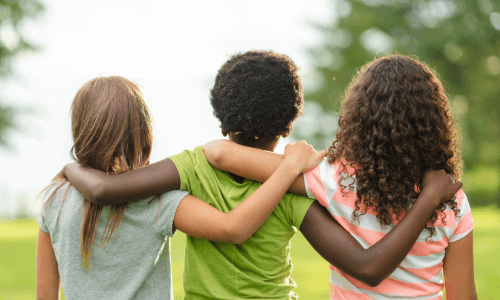
Message of Hope
Noel MacNamara shares a message of hope and recovery taken from his own experience in the role of Kinship Carer.
This article was written by Noel MacNamara, Executive Manager, Research & Policy at the Australian Childhood Foundation, Deputy Director, Centre for Excellence in Therapeutic Care and Carer.
Two years ago, we were called to our kinship care child’s school almost daily. Sometimes she had disrupted other children, sometimes she had poked someone with a pencil, one time she ran out of the classroom and had a great time being chased by the Deputy Principal around the grounds. On occasion, she would become distressed and needed comfort. She would often feign various ailments and have to go to the sickbay. She did not have any friends and the other parents were starting to complain to the school and asking for their children to be moved. This is a very familiar story to many of you who care for children who have experienced trauma and loss.
 Here we are at the end of her 4th year and some big things have happened. Firstly, she has been given her pen licence. A big event for a fourth-grader. Secondly, she has been awarded the most improved student in the 4th grade. Finally, she has a number of close girlfriends and she regularly attends birthday parties and other events at other children’s homes (no sleepovers, a step too far yet). She is a very reliable member of a soccer team. They have not won a game yet, but we have learned to live in hope!
Here we are at the end of her 4th year and some big things have happened. Firstly, she has been given her pen licence. A big event for a fourth-grader. Secondly, she has been awarded the most improved student in the 4th grade. Finally, she has a number of close girlfriends and she regularly attends birthday parties and other events at other children’s homes (no sleepovers, a step too far yet). She is a very reliable member of a soccer team. They have not won a game yet, but we have learned to live in hope!
How has all of this happened?
Patience, love and lots of hard work.
From the moment she wakes up (which is early) we maintain a regulated sense of calm. She will often be right at the edge of her arousal tolerance. You can see that it would take a very small increase in arousal for her to flip her lid. By offering appropriate levels of choice, supporting the choices she makes in respectful ways. Scaffolding the experience of the morning. When it gets to doing her hair, we know that there is a real potential for the morning to be lost. We have built a pattern around this that, for the most part, keeps it together. It sometimes spins out of control and the hairstyle is pulled apart and there is a refusal to start again. Despite how you feel it is so important to remain calm and keep yourself regulated. She needs us to be that part of her brain that she cannot make use of in these moments. We must help her dial it back.
On the way to school, we have a number of anchor points. We always go the same way and we use various locations as triggers for fun and storytelling. When we arrive at school (always with plenty of time to settle) we engage in a word game on my phone. This signals her brain that we are moving from one environment to another.
 The school (which is common) used a cognitive or talking approach to behaviour issues. We have helped them to understand that it is better for our child for them to move to more sensory interventions when she is unable to attend and focus. This helps her to spend much more of her time inside her window of tolerance. This has resulted in far fewer incidents and greater periods where she can concentrate and learn. The school have been really good partners in this process.
The school (which is common) used a cognitive or talking approach to behaviour issues. We have helped them to understand that it is better for our child for them to move to more sensory interventions when she is unable to attend and focus. This helps her to spend much more of her time inside her window of tolerance. This has resulted in far fewer incidents and greater periods where she can concentrate and learn. The school have been really good partners in this process.
Our little girl is moving from a frightened, unsure, unsafe and friendless child to one who can experience the joy in learning, playing and having friends. This is the right of every child. For those children that we care for this is challenging, at times confusing and tiring journey. The most important aspect, we have found, is to always remain hopeful and celebrate every small gain and take care of ourselves.
